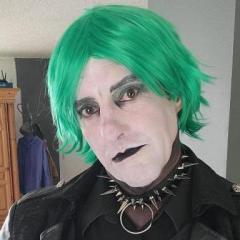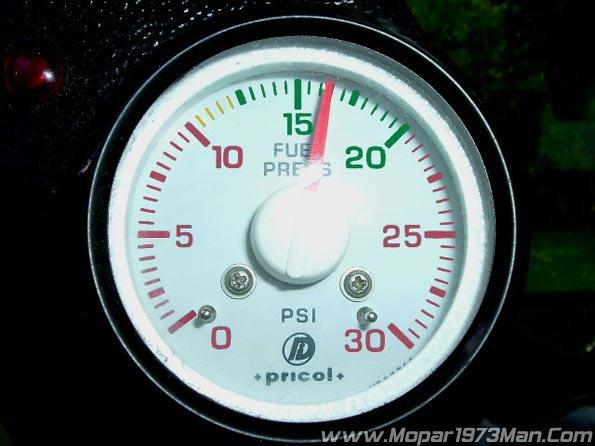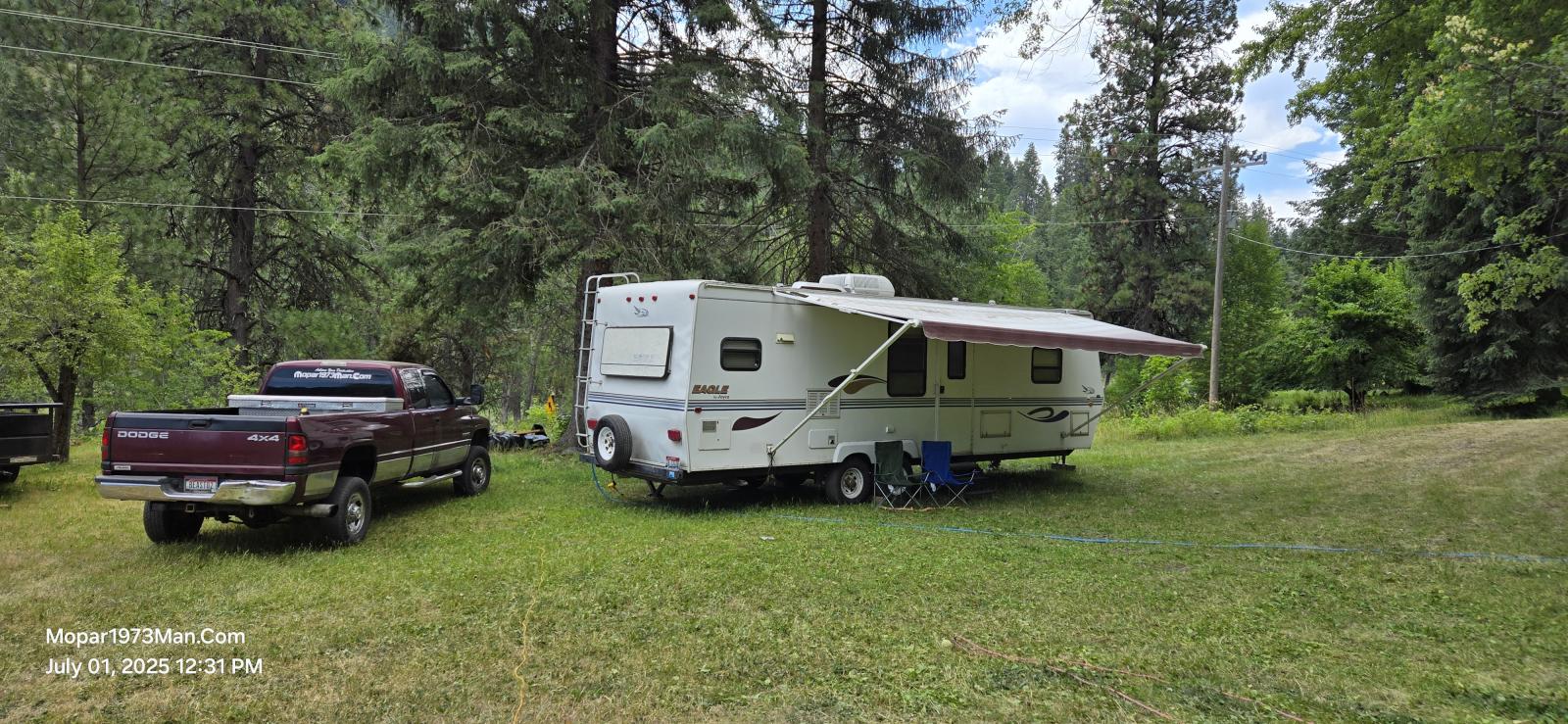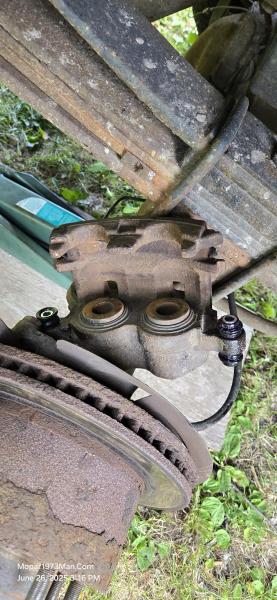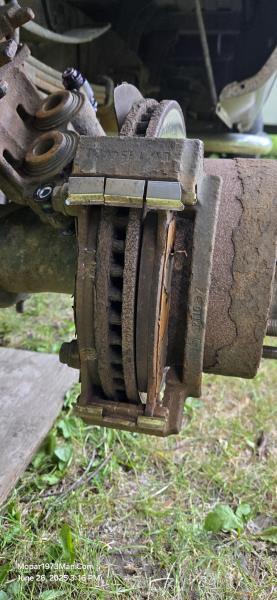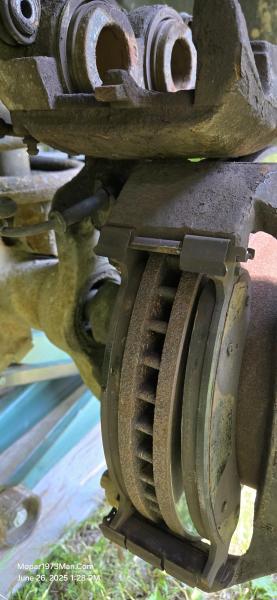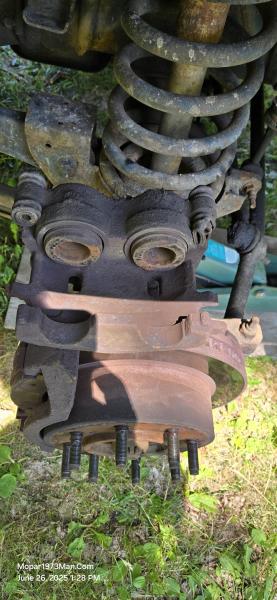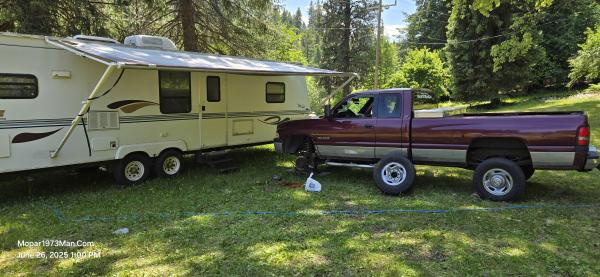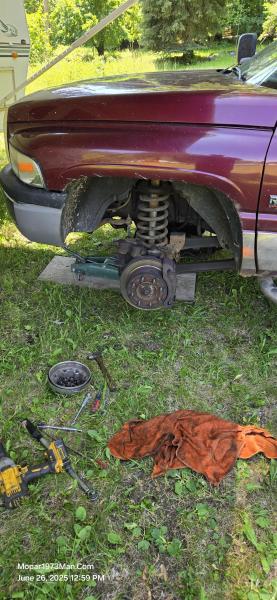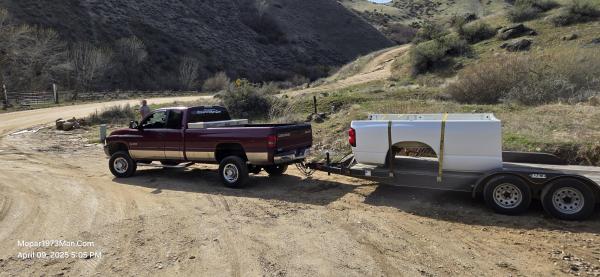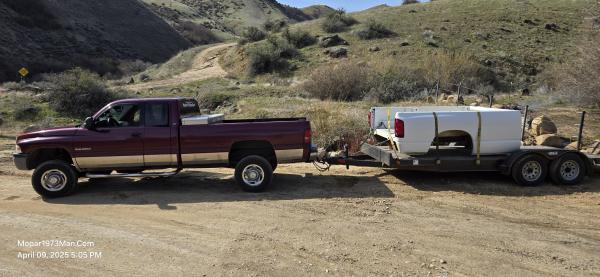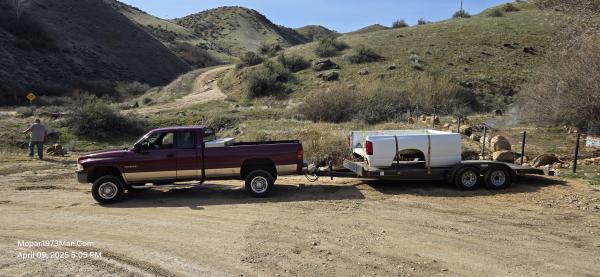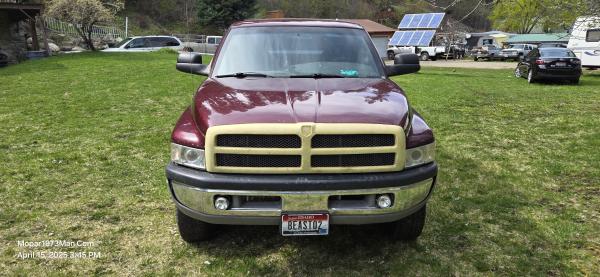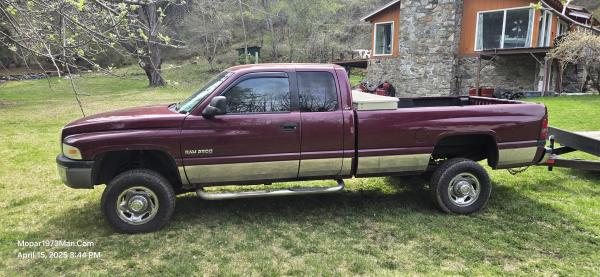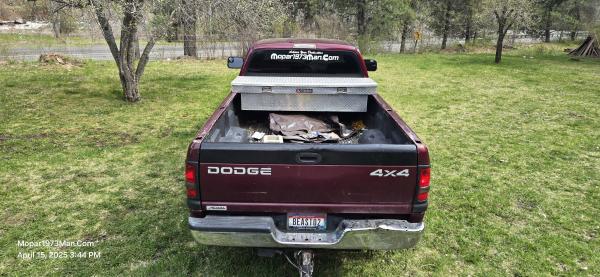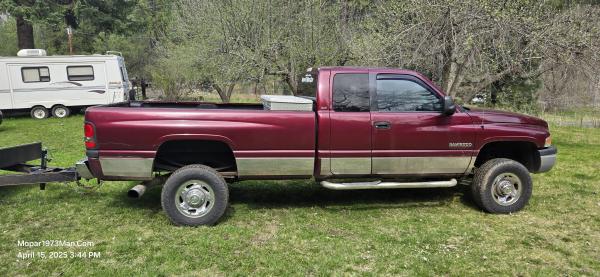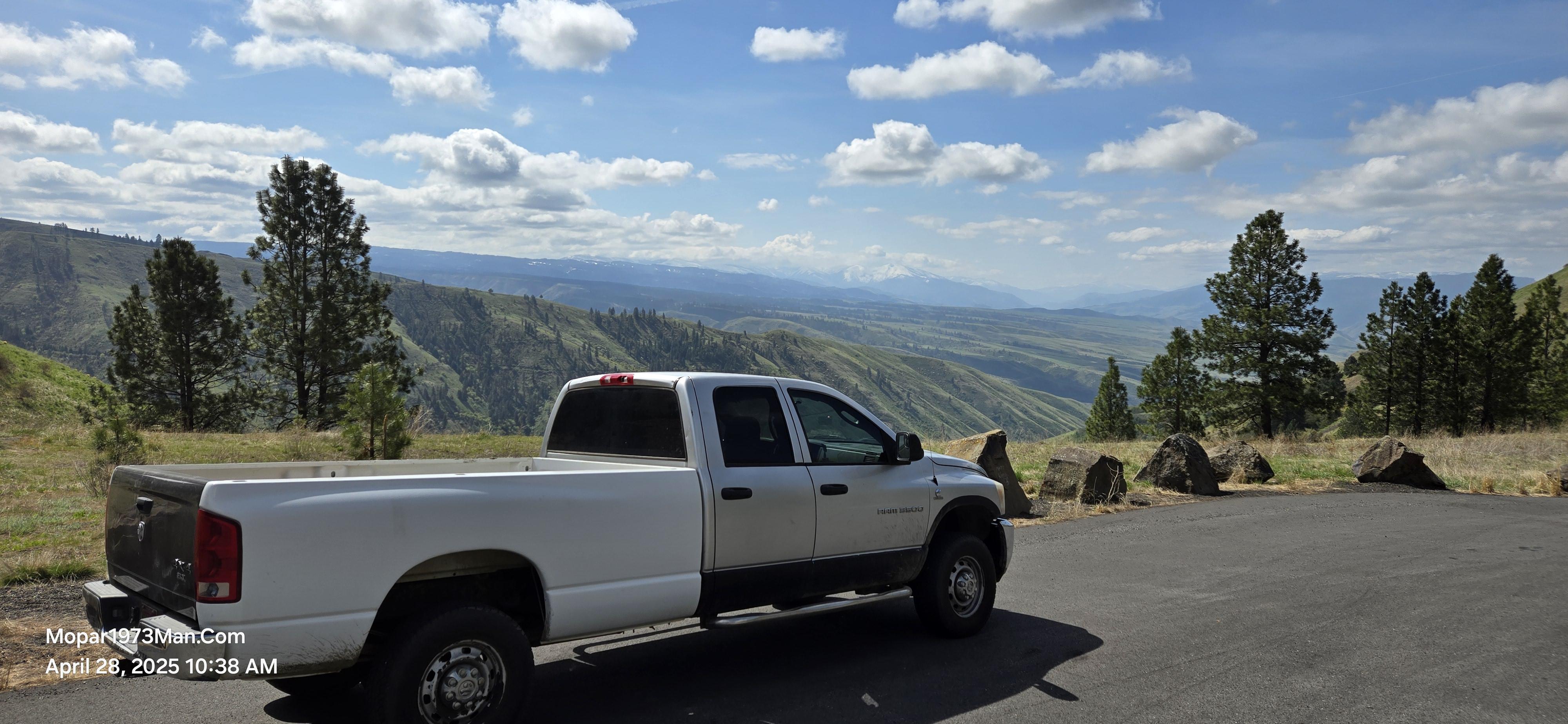
Everything posted by Mopar1973Man
-
2000 Cummins Surge/Dead Pedal
Small correction...
-
We are back from our camping trip
@Tweety Bird And I had to get out of here and get some downtime. Extremely stressful to get up every day, looking out the living room window at an entire mess of my shop buried under tons of mud and dirt. It was wonderful to just go out north of McCall, ID for about 4 days. We didn't do anything but rest. Now we have returned home and are going to start making moves to clean up the main house with all the unpacking from moving to my place. Lots to do. Then still need to handle the mess in my driveway of my shop. Here shortly I'm going to post up a Go Fund Me Page and we are going to attempt to start heading towards normal life again some how. Anyone who wishes to help out, I will not turn you down. As for those who just want to send Prayers, thank you, but it doesn't clean up the mess, replace my shop or my tools that were lost. Beast and the RV are up near Upper Payette Lake, Idaho Miss Mollie on her first camping experience.
-
Problem with idle cut off
it seems like it's mostly fuel related issue. You can't obtain the speed you are requesting of the engine. The idle speed is lower. Be aware idle speed will change with coolant temperature, but typically when it's way high, like above 225℉. I've played with a rheostat and varied the resistance of engine coolant to see what it controls. IAT will change the aspect of the timing of the VP44. The higher IAT is much more stable for efficiency. (80 to 140℉) is optimal. I'll keep thinking on this why I'm working here on the site. I'll dig for an answer.
-
Problem with idle cut off
What is your lift pump pressure to the injection pump? Optimally, you should see 15 to 17 PSI of fuel pressure to the injection pump. Sounds like it's starving for fuel. Measure this at WOT (Wide Open Throttle) at highway speeds to be sure you have plenty of fuel pressure under heavy demands. Here in Idaho, I just got back from camping up in McCall, Idaho, and it was about 100℉ (37°C) outside for the last few days. Remember, I'm running Beast with a 200℉ Thermostat from a 2012 6.7L Cummins with zero issues, even towing my RV. With my Quadzilla I rarely see above 140℉ fuel temperatures, 175℉ engine oil temperature. The only device capable of failure without codes is the VP44. There is several cases where the VP44 just no longer will fuel properly and just not throw any codes being its consider failed within specifications. Sadly its true. ECM will typically have a series of low/high volt codes and P0606. PCM will typically throw P1698 IIRC. This combo is roughly 17,600 pounds (7,983 kgs) rolling up grades of 7% no issues.
-
Trans Crossmember bolts
You could use the part number lookup up tool then do a search on the internet of the part number it would tell you more about the bolts and nuts.
-
Beast
2002 Dodge Ram 2500
-
20250626_151649.jpg
From the album: Beast
-
20250626_151642.jpg
From the album: Beast
-
20250626_132829.jpg
From the album: Beast
-
20250626_132811.jpg
From the album: Beast
-
20250626_130000.jpg
From the album: Beast
-
20250626_125945.jpg
From the album: Beast
-
Shade tree mechanic back at it
Both @Tweety Bird and I gotta have a break from all this. I had to deal with rusted slide pins on the calipers front and rear axle. We managed to find enough of my tools to at least do a simple repair. Suzanna has been busy packing the RV so we can go take a break camping locally. I'm kind of amazed. Got the front brakes done with slide pins. Both side you had to beat the pins out of the boots. The last time I did brakes at 350k miles till now with 497k miles and rolling. Finished this project. Sadly I found my MPG loss. Driver side rear was stuck on the side pins and ate those pads up about 1/4 of a inch left.
-
Mysterious Knock on VP44 Truck – Need Help! No one can figure this out!
Correction. It only reports commanded timing only.
-
Google Search & Webpage CLS
I spent a good part of the day trying to recover from a loss of search engine ranking. Yeah, I have been super busy dealing with insurance agents and people coming and going. Now things are settling down, I jumped back into the website more so. On to the website stuff. My biggest hit was a problem called Content Layout Shift, or CLS for short. We had most of the mobile phone pages were as high as 0.44, which is a huge fail. Now to see this for me I have to logoff and view from a guest level. Yeah this started to explain the problem why the search engine is dropping search results we are falling out of the first place. Now to fix this problem, being I have a dynamic webpage. Mopar1973Man.Com will allow you on a desktop to pull the window frame smaller width-wise and the webpage will automagically change from desktop, to tablet, then to mobile format screen. Basically, we need to make sure that frames for Google Ads are pre-laid out, in other words, reserve space on the screen for the ad to be placed without skewing any page text or graphics up or down. Inside the backend of the website, I have a way to add CSS scripts to the theme so I can alter the way information is displayed. Here is my Custom CSS /* GOOGLE AD CODE FOR RESPONSIVE ADS */ #ipsLayout__main .adsbygoogle { width: 320px; height: 300px; display: block; margin-left: auto; margin-right: auto; } @media (min-width:500px) { #ipsLayout__main .adsbygoogle { width: 480px; height: 300px; } } @media (min-width:800px) { #ipsLayout__main .adsbygoogle { width: 780px; height: 300px; } } @media (min-width:1050px) { #ipsLayout__main .adsbygoogle { width: 1040px; height: 300px; } }Now you have to go back over your Google Adsense code to add a bit of custom code around the Google Adsense code. <div id="ipsLayout__main" class="adsbygoogle"> <script async src="https://pagead2.googlesyndication.com/pagead/js/adsbygoogle.js?client=ca-pub-0000000000000000" crossorigin="anonymous"></script> <!-- Header Ad --> <ins class="adsbygoogle" style="display:block" data-ad-client="ca-pub-0000000000000000" data-ad-slot="0000000000" data-ad-format="auto" data-full-width-responsive="true"></ins> <script> (adsbygoogle = window.adsbygoogle || []).push({}); </script> </div>Here is how the magic works. The custom CSS script creates a container on the webpage. I'm more worried about the height pixel more so than the width. It's the vertical shift of information on the page that is where the issue of CLS comes into play. The CSS script checks the screen size (window) and then, if the window size is at the "min-width" value, then the reserved space is width and height values to the right on the same line. This keeps the layout from moving as the ad loads from Google. The <div> tags in the HTML code of Google AdSense this is what create this container in the code. The results of the code change below. The Google side panel is on the right showing the CLS value of a few random pages.
-
Death wobble for the 1st time ever in a 2nd Gen Cummins
Look for anything with looseness... Shocks - remove and check for gas charge and suppression. Weak shocks can allow the the axle to bounce. Tie Rod Ends - look for any loose tie rod ends. Ball joints - Check for vertical movement by prying upwards on a hanging tire. Tires - Any deformity? Properly balanced? Wheels - Are your wheels true and now bent or out of true? Steering shock - It helps, but it's not a cure-all fix, either like some websites mention. Some people omit this shock.
-
New Gallery Moderator
I would like to welcome @Sufarry to the staff and he will be handling the Gallery Moderation. He's going to get people posting pictures and sharing their truck photos. Thank you.
-
Mysterious Knock on VP44 Truck – Need Help! No one can figure this out!
@Sufarry It was a great conversation on the phone. Sorry, I've been missing in action for a while between the landslide, clearing @Tweety Bird place out, and moving here, and then my bladder cancer. My notes on this after this hour-long phone call. It is not mechanical that we can find it's a bad signal being created by the ECM and feeding the VP44 the bad information, which makes it knock. I know he is waiting for a Cummins crank sensor to arrive. I've got a few ideas, but I just have to wait for the sensor to arrive for the owner to reinstall the starter and give it a try.
-
Problem with idle cut off
4,500 PSI is stock (310 bar) 4,750 PSI is Max (327 bar) 4,250 PSI is Min (293 bar) You want your pressures closer to the 4,500 to 4,600 PSI. Im running 4,641 PSI which is 320 bar.
-
Landslide - Update
First, let me say that for any of you who own your homes, please review your insurance policies. I just found out that the majority of homeowners are not covered for landslides, mudslides, earth movement (earthquakes), etc. Like me, it's a completely lost. The insurance policy doesn't cover this at all, not one dime. For all those religious people who walked up and said they would pray for me. They packed up and left the scene quickly and gave ZERO help at all. Even my neighbor who is part of the same church group, came over drunk with a glass of wine and offered ZERO help. As for @Tweety Bird and myself, I know we have been kind of MIA right now. We have been trying to unload all of @Tweety Bird house into my garage. We are downsizing to financial responsibility. Then, to make matters worse, you start with the NO KINGS protest (https://nokings.org). Most of you know I'm a Trump Supporter! We have one small load of stuff to grab out of her garage, and we are done. The house is going on the market. Nampa, Idaho, is an armpit right now with protests and construction everywhere. Yeah, during my last visit down there, dealing with medical too I was pulled over by a Boise City Police officer in Downtown Boise because of smoke and loud exhaust. (Oops. Wrong tune loaded.) There are state police, county police all over the place because of the possibility of riots because of the NO KINGS protest. So, doing inventory of the house debris, my ATV is damaged beyond repair, both of Mark's trucks are destroyed, and all of Mark's and my tools are scattered all over the place. I don't have a full set of tools! We did get lucky and find, like my bow and Mark's bow. Mark's black powder rifle is undamaged. Still have not found the big double door refrigerator, stove/oven, etc. I'm hoping my MIG welder made it, but doubtful. The washer and Drier of @Tweety Bird is crushed and gone. Currently, I have no way to even pull the injectors out of Thor to send back to @dieselautopower because I've lost most of my tools. Like my air compressor is damaged, shouldn't be used. 4kw generator got ruined, etc. Thousands upon thousands of dollars of damaged tools, equipment, and building, all gone and not covered by my homeowner's insurance. I've gotten some donated funds to keep fuel in the equipment (track hoe, and skid steer) here so we can keep digging. Thanks to the Dischinger Family for bringing TRUE HELP! His wife made us all dinner the night of the slide. Their son AJ, has been helping out with running the equipment and digging up stuff slowly so we can try to recover stuff. Andrew has been super helpful and brought other friends to aid in the dig for our stuff. I'm calling on any of the Mopar1973Man.Com family for help. You all have to remember that since my battle with cancer, I've been dealing with my health problems including my Stage 3a Chronic Kidney Disease and my ostomy that I now have for the rest of my life. This puts me in a bad place where I can't even help to move all this. It's been a challenge just trying to move @Tweety Bird here with me. Even if all you can do is support me on the website as a staff member and watch over the site as I try and handle other problems I've got to handle. Be aware that some people might get their feelings hurt. Understand that their action hurts us as a family. At this point, I want to say to all you "religious people" who keep doing the same thing, "I'll pray for you!" You, my friend, are part of the problem! We have had so many come here to peer at the destruction and just walk away to say the same phrase, "I'll pray for you!" and do absolutely nothing to help us. Please, if you can help, please take action and do the right thing and help. Either with donations, equipment, or time, etc. I've even contacted my local church group to that I was with and got the same answer "I'll pray for you!" Please, I'm truly asking for help to move dirt and clean up this mess that is taking forever because too many people want to do the LAZY thing and "I'll pray for you!" then leave. Video (Tiktok) https://www.tiktok.com/@titaniumgoth/video/7516228282023497002?is_from_webapp=1&sender_device=pc&web_id=7516228666382091807 As you can see, most everything was damaged or turned into junk rather quickly. A few things under plastic that was some computer parts I've kept. They recovered my ATV, which is a total loss. Damaged beyond repair. Mark's 1998 5.9L V8 Magnum truck seriously damaged and possibly a bent frame. It was shoved sideways for about 20 to 30 feet. You can see both my Mother's bicycle and mine are a loss too. All I'm asking for is some help to hopefully clean all this up and then hopefully build a shop in a new location on the property. Like all my ability to do the little articles and such just came to a screeching halt. Without even a basic set of tools, it's tough to do an oil change right now. I don't even have a chainsaw to go get firewood with for winter or even cut the fallen trees up in the landslide. Seriously, I've lost everything! Toss in my cancer battle, social security battle, and now the landslide that wiped out my guest house and shop. It's very depressing and mentally tough to handle on a daily. Just imagine for a second you get up every day and look out your front window, and see this mess. The best you get for help is "I'll pray for you!" Please understand it is not only just me who is affected, but also Mark and Suzanna, we all live together in the main house.
-
As of May 29th, 2025 Mopar1973Man.Com Shop was leveled by a landslide!
Thank you @IBMobile those photos bring back memories.
-
As of May 29th, 2025 Mopar1973Man.Com Shop was leveled by a landslide!
Mopar1973Man.Com Shop was leveled by a landslide.Yeah, with a heavy heart, I lost my entire shop and guest house to a landslide. I won't discuss how this all happened yet. The biggest thing I lost was the entire building. My Best Friend, Mark Hall, was living in my guest house. He was one of the few who helped me out with my cancer. He was protected by a guardian angel. I just saw where his bed landed and what pinned Mark in the house. Mark's Dog Hachi made it too, and no injuries. We managed to hunt for stuff. Like my huge black tool box it was there under the roof lot of our tools between Mark and I. There are tools but scattered all over the ground, spilled out during the landslide. As you can see I had a load of stuff from @Tweety Bird on my BigTex trailer pulled by Thor. We got home at 1:30am and hit the bed by 2am. This event happened at 6am roughly in the morning. I would like to apologize in advance for my being missing in action for the last few weeks, I've been busy getting @Tweety Bird moved in with me. Then the landslide issues were another that really took all my attention from the website for the last few weeks.
-
Problem with idle cut off
Look at my article for injector cleaning to shim the shim which is under the spring in the body.
-
Unable to prime with working lift pump.
Should see positive pressure at all times. Say above 5 PSI. Optimal would be no less than 10 PSI at WOT at highway speed.
-
Unable to prime with working lift pump.
All the check valve and regulator is in the sender. There are only 4 wires. +5V (gauge), sender GND (not body ground), +12V for pump, GND for pump (body ground) Like my previous pump made noise but zero pressure.


